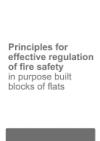This advice has been written to reflect the position once the Fire Safety Act has commenced. It has been published ahead of commencement so that regulators can consider it when preparing for the post-commencement landscape. Bearing in mind that the government expects to commence the Act shortly, LGA, NFCC and CIEH encourage regulators to begin considering joint activity and strategies without delay.
These principles do not constitute legal advice. Enforcing authorities must consider their individual circumstances and arrangements in their own area and seek their own legal advice.
These principles have been developed to support local authorities and fire and rescue authorities to effectively regulate fire safety in purpose built blocks of flats. These principles are intended for buildings over 11 metres but may be utilised for other building types. These principles are not intended for houses in multiple occupation and do not replace the Memorandum of Understanding (MoU) which accompanies the Local Authorities Coordinators of Regulatory Services (LACORS) guidance nor are they intended to apply to local authority owned and managed blocks of flats.
These principles are intended to supplement existing guidance and support consistent decision-making. They are not binding on enforcing authorities and do not constitute legal advice.
The involvement of individual local authorities with the regulation of purpose built blocks of flats is multi-faceted and includes;
- planning
- building control
- housing enforcement
- health and safety enforcement
Within each local authority a range of departments may need to be engaged in ensuring the safety of residential buildings.
Fire and rescue authorities (FRAs) have a statutory duty to enforce the provisions of the Fire Safety Order in regulated premises in relation to purpose built blocks of flats the Fire Safety Order applies to the structure, external walls and any common parts of the building including doors which open onto common corridors. The Fire Safety Order does not extend to the individual flats where they are occupied as a single private dwelling. Fire and rescue services are required to produce an Integrated Risk Management Plan which considers the risks in their area and sets out how its functions will be delivered to prevent fires and other incidents and mitigate the impact of identified risks.
Local Housing Authorities (LHAs) have a general duty to keep housing conditions in their area under review. Housing Act powers require an assessment of hazards and the risk they pose to the health and safety of occupants and visitors. Fire is one of 29 hazards that are required to be assessed as part of the Housing Health and Safety Rating System (HHSRS). The HHSRS and powers under the Housing Act can be used to take action in relation to individual dwellings (where these are occupied as a residents only or principal home) and the escape routes from the dwellings. In cases where a local authority suspects there may be a hazard it has a duty to inspect the premises. Where an inspection has been undertaken and a hazard identified in a residential premises the LHA has a duty to take action in relation to Category 1 Hazards and a power to take action in relation to Category 2 Hazards.
Both FRAs and LHAs are required to have regard to the principles of the Regulators Code.
The Housing Act 2004 and the Regulatory Reform (Fire Safety) Order 2005 offer different mechanisms to address the risk of fire in a building. The Fire Safety Order is focussed on the management of fire risks in the building as a whole and the risk to residents from a fire in the building but not within their individual dwelling. The Housing Act 2004 is primarily focussed on the risk to residents from fire in individual dwellings and their associated escape routes together with reduction of the risk in the building as a whole. The Fire Safety Order is primarily concerned with the safety of the building in the event of a fire. The different legislative powers can be used in isolation or as part of a co-ordinated approach to holistically addressing safety concerns. The extent to which either piece of legislation is appropriate will require determination on a case by case basis.

